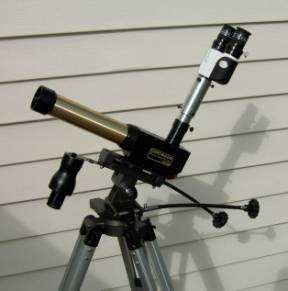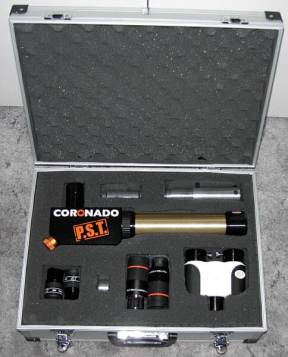|
Binoviewers and the PST We originally purchased our Wiiliam Optics binoviewers for use with our dobsonian telescopes, and Gail and I have enjoyed some incredible two-eyed views of the Moon, Saturn and Jupiter. Yet, at the back of my mind was always the thought that binoviewers can also enhance the observing experience with another instrument – the Coronado PST. At just over 15” (38cm) long with an aperture of only 40mm, the PST is probably the smallest scope any serious amateur astronomer will ever own. At first glance one wonders if anything worthwhile can be seen through it, however, when properly “tuned” this specialized little unit shows amazing detail of the Sun’s surface and filaments of flame, called prominences, extending from the limb. The image is small but, once the eye is trained, subtle changes to the features can easily be detected from hour to hour. Where premium eyepieces will naturally improve the view, binoviewers can take it up another notch from there. My first look through a binoviewer-PST combination was a few years ago, at Starfest. Within minutes of stopping at the Denkmeier booth I knew that if I ever acquired a PST I would want to get binoviewers to go with it. As it turned out, we got the binoviewers first so when it came time to purchase the PST the decision to do so was that much easier. Like most Newtonian scopes, PST’s also require a corrector set to bring binoviewers to focus. Denkmeier sells a corrector specifically designed for their brand for $179. For other makes, like our William Optics unit, $119 will get you a corrector set from Siebert Optics.
The Siebert set consists of an extension tube, an adapter tube, and a lens cell. The extension tube slips into the PST’s focuser shaft, the adapter tube slides on top of that to lengthen the light path, and the cell with the corrector lens screws into the bottom of the binoviewer which is then inserted into the top of the adapter tube. Six nylon screws help to secure the pieces in place. The corrector lens acts somewhat like a barlow in that it magnifies the image 1.3x. This makes 20mm eyepieces seem more like 14mm ones, which is fine since it gives you a closer view of the target while maintaining the comfortable eye relief of low power ep’s. Though this combination will fit the Sun’s entire disc in the field of view, the PST does have a “sweet spot” which necessitates moving the image around in the FOV to bring individual regions into better focus. All of the advantages to binoviewers when paired with other types of scopes are as relevant, if not more so, with the PST. However, there are some mechanical considerations to this setup. After inserting the assembled binoviewer/corrector combination into the PST’s focuser shaft the rubber cup of each eyepiece is about 14” (36cm) above the OTA. This requires a sturdy mount and, depending on what kind you have, you may have to rig up or add to your counterweight system to balance the rig.
I use an alt-az mount with manual slow motion controls. I have read that an equatorial mount is not as well suited because of the oblique angle it can put the unit as it tracks the sun. To get your particular make of binoviewers to focus you will likely have to slide the adapter tube up the extension tube – this takes a little experimentation after which you tighten the nylon set screws to hold the correct length. This really only takes a minute but, once you have done that, it’s a good idea to use a fine black marker to indicate where on the extension tube the adapter tube lines up. That way you can quickly find the correct length, again, if you disassemble the pieces. One other tip, that isn’t exclusive to the use of binoviewers but comes into play with the PST, is to put some sort of blanket over your head to block out daylight when observing. This really enhances the contrast of the views and the best design for this seems to be two rectangles of material sewn back to back – one silver to reflect the sun, and the other black for its light-baffling quality. There are several variations sold online for $35-$60 but you could probably make your own with a piece of dark cloth and an inexpensive mylar survival blanket. Speaking of DIY, there is a storage case designed to fit the PST which retails for about $70. However, my article “A Case For DIY” describes how you can make a sturdier custom case for about $50. So I did. Here’s a picture of the case I made to house the PST, Binoviewers, and related accessories.
In closing, the price of decent binoviewers is now less than many high-end eyepieces – and, depending on the rate of exchange, so is the cost of a PST. Put them together and you definitely have a situation where the whole really is greater than the sum of the parts.
Copyright - Glenn Muller, 2008
|


